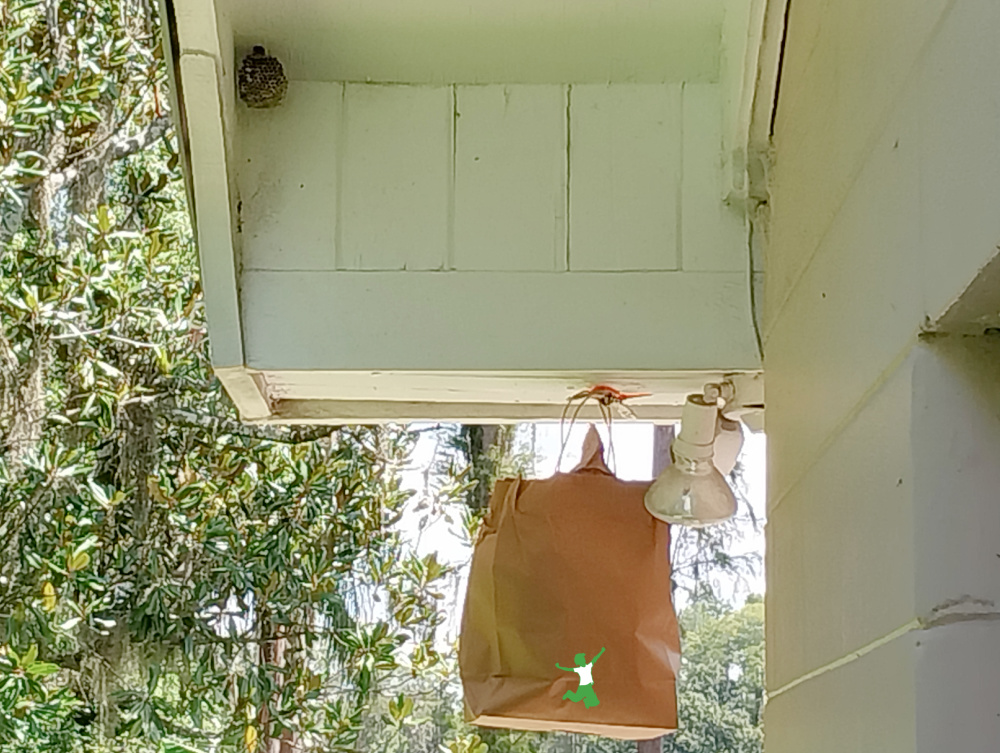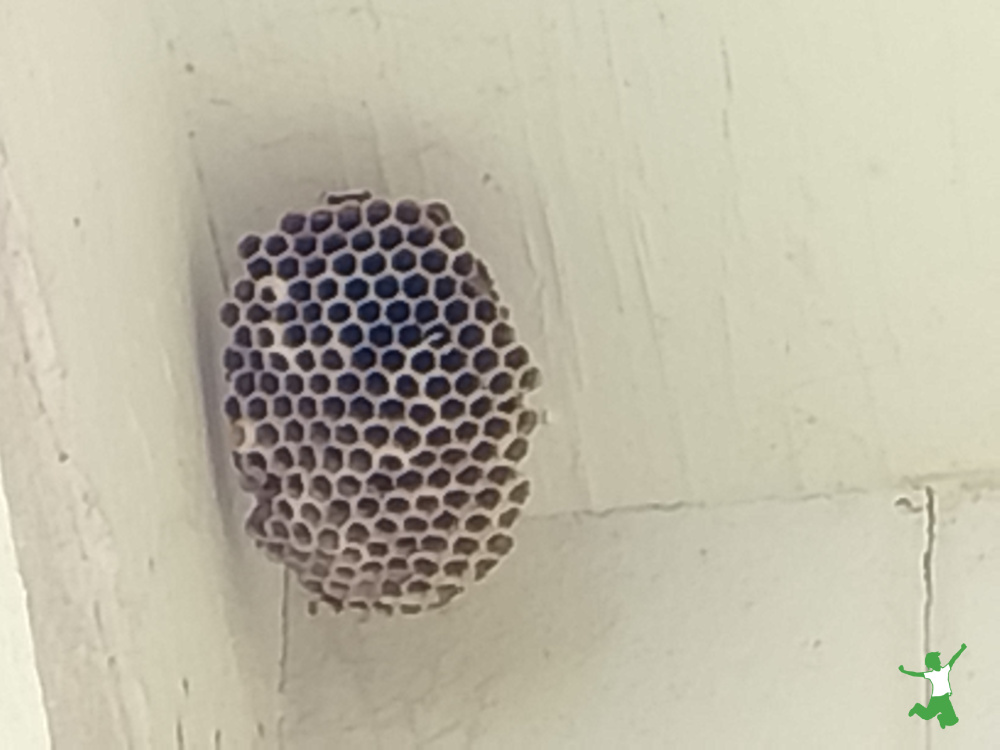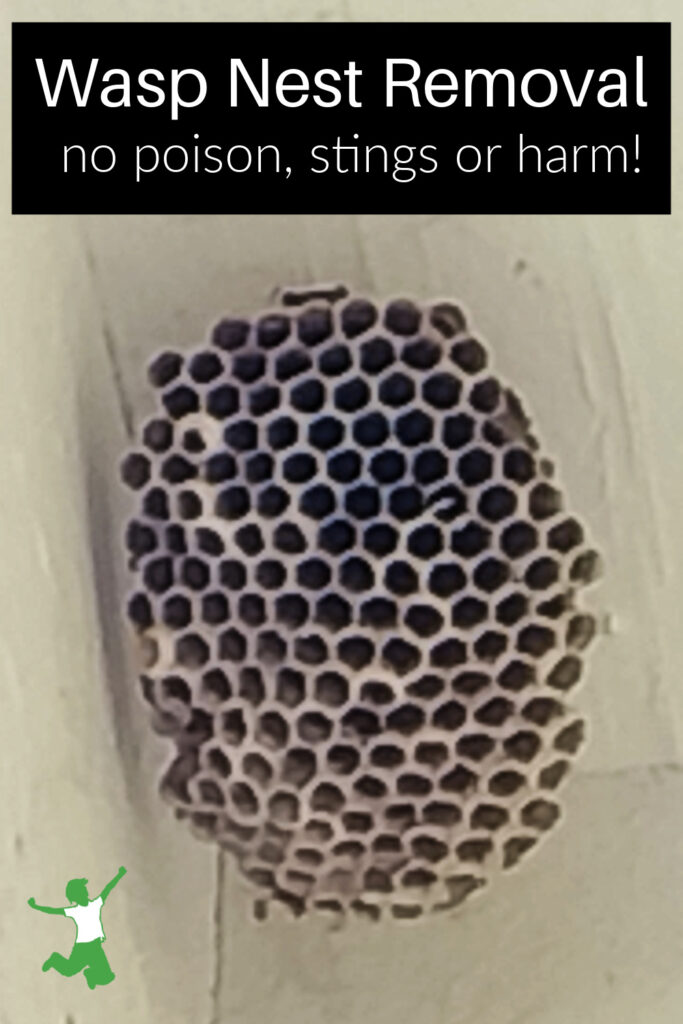Table of Contents[Hide][Show]
How to safely remove a wasp nest with no harm to these important pollinators, no risk of stings to you, and no poison!

Over the years, I’ve shared many safe, alternative methods for pest control in and around the home.
Wasps, however, were always a difficult problem for me to solve.
While getting a small flock of backyard chickens eliminated wasp nests from porch railings and hidden inside bushes, several large wasp nests still pop up during the spring and summer months.
They usually appear underneath the eves of the house, well out of reach of my feathered friends!
Removing these nests has always been a tricky situation for several reasons.
Wasps are Critical Pollinators and Predators
Wasps are very important pollinators in the food chain.
And, since I have a large garden as do many of my neighbors, preserving pollinators for the community is very important!
Besides pollination duties, wasps also reduce the population of pests that can plague food crops such as caterpillars and whiteflies. In the case of caterpillars, they accomplish this by laying parasitic eggs inside the caterpillar.
As meat eaters, wasps also reduce the population of other nuisance insects. Even a small wasp colony can consume up to 3,000 flies, mosquitos, and spiders per day as a protein source. (1)
In short, it is not okay to kill wasps in the majority of circumstances.
Finding a way to move them such as you would do with a honeybee colony found in your garage is a much better approach for both you and the environment!
Poison is a Non-Starter
I haven’t ever used poison to remove wasps, nor would I ever call a pest control company to perform this service either.
Poison not only kills them, which is counterproductive to the ecosystem as described above, but it is also a toxic endeavor for the homeowner.
Wasps commonly build nests underneath the eves of a home. This can also be in close proximity to windows, where toxic fumes can gain access to the interior of the home.
Just say no to poison when it comes to eliminating wasp nests!
Risk of Multiple Stings
Once you’ve realized that killing the wasps is not ideal, then the next thing that is of concern is the high risk of getting stung during the wasp nest removal process.
In other words, if you’re in the “don’t kill the wasps” camp, simply knocking down the nest so they have to seek greener pastures elsewhere is risky business.
Unlike honeybees, which only sting you once, a single wasp can inflict multiple stings in an instant.
This can happen through thick clothing like a pair of jeans too!
I’ve been known to take a broom, knock down a wasp nest in the early morning when activity is low, and then run as fast as I can into the house. 😂
I’ve had so many wasp stings over the years that I’ve honestly lost count. This home remedy for wasp stings is my go-to treatment to avoid swelling and a possible allergic reaction.
Of course, now that I have a honey-producing backyard beehive, I can put on my beekeeper suit for such a task. That seems like overkill, at least to me though!
Wasps Quickly Rebuild Nearby
Another problem with the “knock down the nest” method is that the wasps can quickly build a new nest nearby.
So, while you succeed in removing one nest, you have not succeeded at all in deterring the wasps from taking up residence under another roofing edge, eve or overhang as close as a few yards away!
Thus, just knocking down the nest is a vicious circle that never really ends.
Best Approach to Remove a Wasp Nest
The good news is that there is an easy method that both preserves the wasps, prevents you from getting stung, AND encourages the wasps to build a new nest far away from your house.
This approach is what I call the “brown paper bag” method for wasp removal, for lack of a better name.
You see, wasps are highly territorial.
So, if they see a mega-hive nearby, the residents of the smaller hive are going to skedaddle for greener pastures elsewhere.
As you can see from the picture below, this rather large wasp nest emptied out in a hurry at my home! Once the wasps are gone, you can safely remove the nest with no poison and no risk of stings!

Brown Paper Bag Method
All you need to punk the wasps into moving to another location that is not near your house is to hang a brown paper bag within a few feet of the nest.
The brown paper bag is a fake nest that triggers alarm in the wasps to quickly vacate the premises.
As long as you are not disturbing the existing nest, there is little risk of getting stung. I suggest hanging it during times of low nest activity such as early morning or dusk.
If you don’t have a brown paper bag handy (supermarket versions work great), then a long piece of brown paper that comes as part of the packing material for deliveries is a good substitute.
Types of Wasps Affected
This method works for social wasps that live in colonies. In my area of the country, that would primarily include paper wasps as shown in the photo above.
The brown bag approach also works for northern paper wasps that build sturdier nests with the larvae cells completely enclosed.
Note that this method is ineffective for solitary wasps that build individual nests such as thread-waisted wasps.
Instructions
Simply shape a brown paper bag with your hands so that it looks like a massive wasp nest.
Then, attach it underneath a roofing edge nearby.
The process of the wasps leaving the old nest and rebuilding some distance away can take anywhere from a few days to a couple of weeks.
Weather Affects Effectiveness
The only challenge to the effectiveness of this method is the weather.
If it rains, then the brown paper bag becomes a soggy mess and falls down. So, be sure to gauge when you will have a dry spell of at least a few days. A full two weeks is best.
You will also want to take care to place the bag in a spot where the morning dew won’t dampen it, potentially causing it to disintegrate.
How to Know When the Wasps Have Moved
Once the wasps are gone, you can safely knock down the old nest without any risk to yourself or the wasps (who are long gone living somewhere else anyway).
Early morning and late evening are the least active times for wasps. (2)
Thus, the middle of the day is the best time of day to check for any residual colony activity.
Once you see no activity for a day or two, then the coast is clear to remove the old nest as the wasps are safely homesteading elsewhere.
Have you tried the brown paper bag approach for removing a wasp nest? Let me know about your results!

(1) Is it Okay to Kill Wasps?
(2) What to Know About Wasp Nests








I’ve been using the paper bag method for 4 years now. Very effective. I use small or large paper bags and place them near a known wasp nest. Thicker paper is best for outside, like hanging from a tree. I place a recyclable bottle inside and upside down so the bag can keep its shape even if wet. I don’t like for the bags to be visible from the street, so different sizes have worked for me. I replace as necessary. Have not had new nests in years!
Awesome! Had not considered using it as a preventative too!
I also started faking them out years ago but used the purchased version of a fake nest. They are paper stretched on a wire frame and as long as they don’t get wet, last for years. I purchased mine on Amazon but have seen them in garden stores too. I hang them early in the spring as soon as the rains slow down (I’m in the PNW) and place them under my eves and decks on all sides of the house with one or two on each sides and quite a few under the deck (their favorite spots). I still get nests out in the yard where they happily coexist and are awesome predators. When a yellow jacket underground nest becomes a problem, I just cordon it off with caution tape until late fall when they get less aggressive.
I recently bought those wasp nest decoys on Amazon that look a bit like festive paper lanterns, which seemed prettier hanging around my patio than paper bags. Unfortunately, the wasps couldn’t care less and built a giant nest just a few inches from one of them. I wonder if paper bags would be more effective, though these really should have worked.
I was going to suggest that somebody needs to market a waterproof, fake wasp nest. If this truly is a viable idea. You don’t have to struggle with the paper/water issue.
We have a lot of mud Dobber as we call them wasps which I think might be the lone wasp you’re referring to.
Can’t honestly say I realized there are so many different wasps or that they are pollinators.
On a related note, a neighbor told me a wonderful solution for getting rid of ground bees (yellow jackets, etc) that build nests underground. He just pops a marshmellow or something sweet (granola bar, etc.) into the hole in the evening, and that attracts the skunks, which then happily eradicate the nest, as they consider bees a delicacy! I tried this when yellow jackets nested in a raised bed; within a few nights, they were gone!
Great article, as usual, Sarah.
I have to admit, I have successfully eradicated wasp nests in Idaho by knocking them down and outrunning them but I don’t recommend that for anyone else. I also inundated the whole circumference of the house with a lot of peppermint essential oil spray heavily to discourage them from return. They stayed away as long as I kept reapplying the peppermint.
What a great idea!
Do you have a recommendation on how to get rid of in the ground hornets?
It’s horrific this year.
Would love any recommendations
Thank you
Hi Sarah,
Years ago I saw an idea similar to this online. A lady crocheted a wasp’s nest using a yarn similar in color to the real wasp nest, then followed the same procedure you describe with the paper bag. This would work well in area’s that have rain more often because the crocheted nest would not be wrecked by rain. It could even be washed and reused multiple times.
Katie
Love this idea!
I just looked this up … and check this out!
etsy.com/market/crochet_wasp_nest